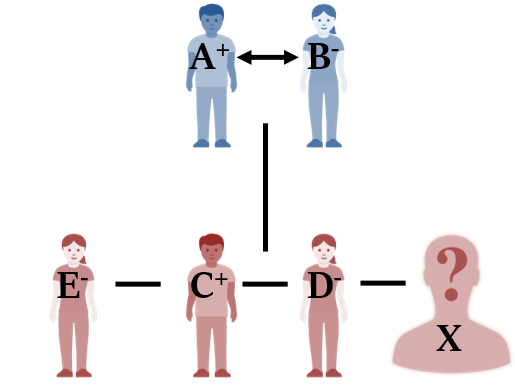Drawing Family Tree
Symbol Conventions
We will represent male gender by + sign or rectangle and female gender by – sign or circle.
The relations in the same generation are shown with horizontal lines (-) and among generations above and below with vertical lines (|).
Marital relations may be shown with double horizontal lines (=) or two-sided arrow (↔).
Steps
Firstly try to find out the two persons among whom the relation is to be found.
Then based on the relations between the other members of the family given as intermediaries try to establish the relation between the two required persons.
Always use pictorial representation to solve the question because in this form you can systematically arrange the data.
Consider the following family tree:
 A and B are a couple. A is the husband and B is the wife. They have four children - one son (C) and two daughters (D and E). Gender of one child is not known.
A and B are a couple. A is the husband and B is the wife. They have four children - one son (C) and two daughters (D and E). Gender of one child is not known.
Let us point out some of the relations in this family.
A is the father of C, D, E and X. Similarly, B is their mother.
C is the son of A and B. He is also the brother of D, E and X.
E and D are sisters of C and X.
Note that, if you are asked the relation of anyone in the family with X, you will be able to answer.
E.g. What is the relation of A with X? - A is the father of X
What is the relation of E with X? - E is the sister of X
But you won’t be able to tell the relation of X with anyone, as gender of X is not known.
E.g. What is the relation of X with A? - X can be the son or daughter of A.
What is the relation of X with E? - X can be the brother or sister of E.
So, keep in mind, if gender of a person is not known, you won’t be able to tell the relation of that person with others in most of the cases.
This is because most of the relations indicate the gender too, e.g. when you say brother, you mean a boy; when you say aunt, you mean a lady and so on.
There are very few relations that are gender neutral, e.g. cousin, sibling.